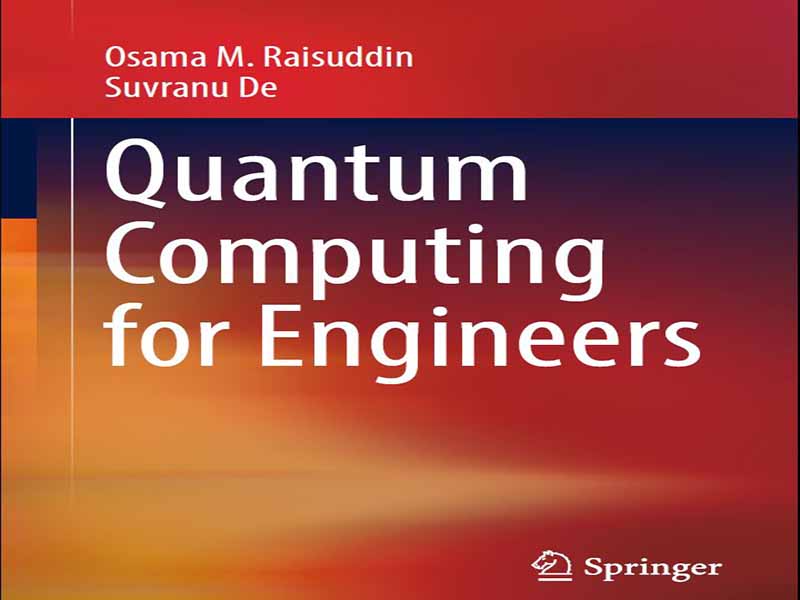- عنوان کتاب: Quantum Computing for Engineers
- نویسنده: Osama M. Raisuddin, Suvranu De
- حوزه: برنامهنویسی جاوا
- سال انتشار: 2025
- تعداد صفحه: 297
- زبان اصلی: انگلیسی
- نوع فایل: pdf
- حجم فایل: 11.9 مگابایت
محاسبات کوانتومی یک حوزه به سرعت در حال ظهور است. همانطور که محققانی از خارج از حوزههای سنتی، مانند فیزیک نظری یا علوم کامپیوتر، وارد این حوزه میشوند، ما این چشمانداز را غنی و در عین حال پراکنده یافتیم – سرشار از نوید، اما پیمایش آن بدون یک چارچوب منسجم و کاربردی دشوار است. این کتاب حاصل تلاشهای خود ما برای عبور از آن آستانه از روشهای محاسباتی کلاسیک به محاسبات کوانتومی – نه به عنوان فیزیکدان، بلکه به عنوان مهندسان محاسباتی – و ایجاد یک پل عملی برای دیگرانی است که مایل به انجام همین کار هستند.
در حالی که چندین متن مقدماتی وجود دارد، اغلب فرض را بر آشنایی قبلی با نظریه کوانتومی یا پیچیدگی محاسباتی میگذارند. هدف ما متفاوت است: ایجاد پلی از مهندسی کلاسیک و محاسبات علمی به الگوریتمهای کوانتومی، بدون قربانی کردن عمق فنی. این کتاب یک دیدگاه کاربردی و الگوریتمی را اتخاذ میکند که مبانی ریاضی، مدلهای محاسباتی و کاربردهای دنیای واقعی را ادغام میکند.
این کتاب به هفت بخش تقسیم شده است که هر کدام به فصلهای متمرکز تقسیم شدهاند. این فصلها به صورت ماژولار و مستقل در نظر گرفته شدهاند و به مدرسان یا خوانندگان اجازه میدهند تا آنها را با مسیرهای یادگیری یا علایق مختلف تطبیق دهند:
بخش اول: مقدمات ریاضی و محاسباتی
مطالب بنیادی در جبر خطی، احتمال و روشهای عددی، متناسب با زمینه کوانتومی.
بخش دوم: مقدمهای مختصر بر مکانیک کوانتومی
پدیدههای کوانتومی اصلی ارائه شده از طریق آزمایشهای کلیدی، با تأکید بر شهود فیزیکی.
بخش سوم: عناصر محاسبات کوانتومی
چارچوب محاسباتی محاسبات کوانتومی – کیوبیتها، گیتها، مدارها و اندازهگیری.
بخش چهارم: برنامهنویسی کامپیوترهای کوانتومی
جنبههای عملی کار با سیستمهای کوانتومی، شامل پشتههای نرمافزاری، نویز و کتابخانههای موجود.
بخش پنجم: الگوریتمهای اولیه، زیرروالها و چارچوبها
اجزای الگوریتمی قابل استفاده مجدد که بلوکهای سازنده روشهای پیشرفتهتر را تشکیل میدهند.
برای دانشجویان مهندسی و تازه واردان به محاسبات کوانتومی، بخشهای اول تا سوم پایه و اساس لازم را ارائه میدهند و بخشهای چهارم تا پنجم ابزارهای برنامهنویسی و الگوریتمی اصلی را معرفی میکنند. برای محققان و متخصصان پیشرفته، بخشهای پنجم تا هفتم، بررسیهای عمیقی از چارچوبها و کاربردهای الگوریتمهای کوانتومی ارائه میدهند و در صورت نیاز به نظریه زیربنایی نیز اشاره میکنند.
برای مدرسان، هر فصل میتواند به عنوان یک ماژول مستقل در یک دوره پیشرفته در سطح کارشناسی یا کارشناسی ارشد عمل کند. ساختار ماژولار، امکان ادغام انعطافپذیر در برنامههای درسی موجود در رشتههای محاسبات، ریاضیات کاربردی یا مهندسی را فراهم میکند.
Quantum computing is a rapidly emerging field. As researchers entering the field from outside traditional domains, such as theoretical physics or computer science, we found the landscape both rich and fragmented—dense with promise but dif-ficult to navigate without a cohesive, application-oriented framework. This book was born from our own attempts to cross that threshold from classical computa-tional methods into quantum computing—not as physicists, but as computational engineers—and to build a practical bridge for others who wish to do the same.
While several introductory texts exist, they often assume prior exposure to quantum theory or computational complexity. Our aim is different: to build a bridge from classical engineering and scientific computing to quantum algorithms, without sacrificing technical depth. This book adopts an applied, algorithmic perspective, integrating mathematical foundations, computational models, and real-world applications.
The book is organized into seven parts, each divided into focused chapters. These chapters are intended to be modular and self-contained, allowing instructors or readers to adapt them to different learning paths or interests:
Part I: Mathematical and Computational Preliminaries Foundational material in linear algebra, probability, and numerical methods, tailored to the quantum context.
Part II: A Brief Introduction to Quantum Mechanics Core quantum phenomena presented through key experiments, emphasizing physical intuition.
Part III: Elements of Quantum Computing The computational framework of quantum computing—qubits, gates, circuits, and measurement.
Part IV: Programming Quantum Computers Practical aspects of working with quantum systems, including software stacks, noise, and available libraries.
Part V: Algorithmic Primitives, Subroutines, and Frameworks Reusable algorithmic components that form the building blocks of more advanced methods.
For engineering students and newcomers to quantum computing, Parts I–III provide the necessary foundation, and Parts IV–V introduce core programming and algorithmic tools.
For researchers and advanced practitioners, Parts V–VII offer in-depth treat-ments of quantum algorithmic frameworks and applications, with references to the underlying theory where needed.
For instructors, each chapter can serve as a standalone module in an advanced undergraduate-or graduate-level course. The modular structure allows for flex-ible integration into existing curricula in computing, applied mathematics, or engineering.
این کتاب را میتوانید از لینک زیر بصورت رایگان دانلود کنید:
Download: Quantum Computing for Engineers



































نظرات کاربران